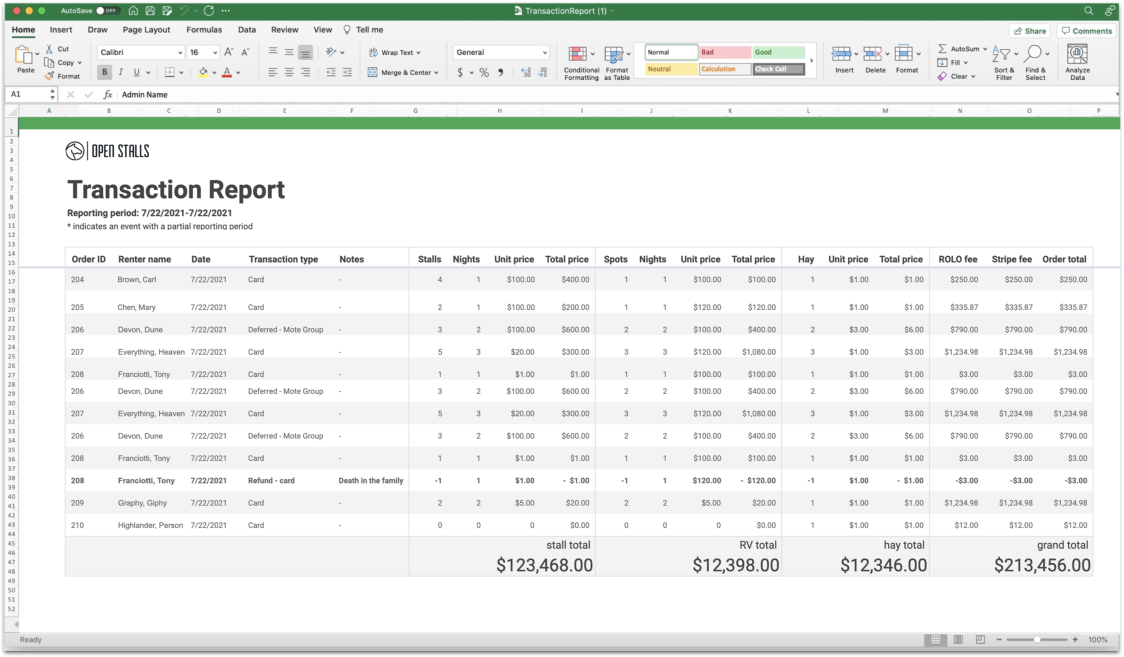Editing a reservation and reporting・ January 2021 - June 2021
Open Stalls
OVERVIEW
Open Stalls is the premier digital solution for Western Lifestyle Venues, providing software to manage stall and RV spot rentals for rodeos across the United States and Canada.
As a lead product designer, I addressed user frustrations by improving reservation editing capabilities based on feedback from Open Stall's rodeo admins.
OBJECTIVE
Faster Reservation Edits
Reduction in the Volume of Support Calls
Increase in Admin Generated Reports
ROLE
Lead Product Designer, Product Strategy, User Research, Prototyping & Testing, Information Architecture
KEY RESULTS
97%
Reduction in refund transaction time
0
Support calls during largest event
100%
Self serviced reports in the first 7 days
Solving Major User Challenges for the Open Stalls Platform
Streamlining Reservation Management
Open Stalls launched with a core feature set that required admins to create new reservations when renters wanted to purchase additional products. Admins were also forced calculate any refunds made to the reservation without making adjustments to reservation. I led a series of qualitative interviews with admins that helped uncover serious pain points in their experience.
Major User Problems:
Admins were forced to manually calculate refunds prior to making edits
Human error in refund calculation led to inaccurate financial reporting
Admins were prevented from extending the dates of reservations
Admins were not able to move stalls and RV spots around operationally without canceling the reservation, even if there were no charges or refunds occurring from the edit
Renters regularly had multiple reservations for one event, which strained our database and caused the tool to run slower when the admins needed to do renter lookups
Admins needed to make paper notes to keep track of various renter requests
Original refund flow
Because the system forced manual calculation, reporting reflected frequent human error when refunding
Problem Statement
It became clear that our system required more flexibility. We asked ourselves, “how might we enable rodeo admins to quickly attend to reservation edits, and ensure accurate reporting?”
Leveraging existing UI patterns found in the app, I created two edit reservation prototypes and began a/b testing to determine which design worked best for admins.
“How might we enable rodeo admins to quickly attend to reservation edits, and ensure accurate reporting?”
A/B Test
What
Design A: Stepped Out, editing functionality is stepped out page to page
Design B: Long Form, all editing functionality on one page
Determine which design best helps admins quickly and easily handle additional charges, refunds, lot and spot reassignment, making notes, and referencing order history for a reservation
Who
20 total participants consisting of a select group of admins and anonymous users unfamiliar with our software
Anonymous testers were recruited from Maze.com
How
Moderated task analysis and one-on-one, in-depth interviews using Maze and Zoom
Participants were asked to perform a series of 9 tasks
Task Analysis
Maze made collating the data generated from the A/B test a snap— in less than a few days we had quantifiable data to base design decisions on. We then applied these new insights and ideas to our final prototype, which we again tested on new and experienced users.
Design A: Stepped out flow, “Updated” chips, “Discard Edits” button, no itemization
Design B: Sections accordion open, “Back” button, no highlights, shows itemization
Click and Heat-mapping
Drop points
Final Design & Outcomes
Qualitative feedback from experienced users favored Design A.
The new feature allowed users to add or subtract from a single reservation has significantly improved the editing process for admins.
Admins reported a time-saving of over a minute compared to the previous process.
The number of support calls during the largest rodeo for the year went from 22 to zero.
Admins exported 100% of their own reports in the first 7 days of release



